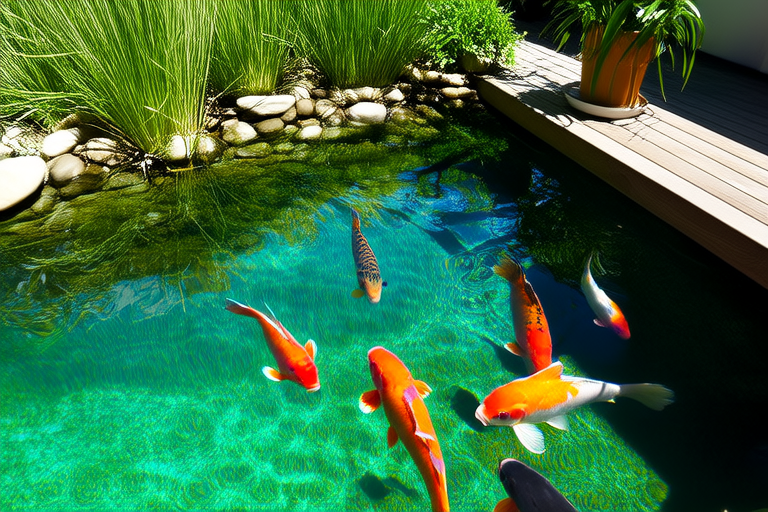The Ultimate Guide to Creating a Stunning Koi Pond in Your Backyard
Creating a koi pond in your backyard is more than just adding water and fish; it’s about crafting an oasis of tranquility that enhances your outdoor space. Whether you’re a beginner or an experienced pond enthusiast, this guide will walk you through every step of the process—from planning to maintenance—so you can create a stunning koi pond that thrives for years to come.
Planning Your Koi Pond
Before breaking ground, careful planning is essential. A well-thought-out design ensures your pond meets both aesthetic and functional needs.
1. Choose the Right Location
Selecting the perfect spot is crucial. Look for:
- Sunlight: Aim for partial shade. Too much direct sunlight can lead to algae growth, while too little can hinder plant growth.
- Accessibility: Ensure the pond is easily accessible for maintenance and viewing.
- Proximity to Trees: Avoid areas with overhanging trees to minimize leaf debris.
2. Determine the Size
Koi need ample space to thrive. A general rule is 10 gallons of water per inch of fish. For example, if you plan to have five 8-inch koi, your pond should hold at least 400 gallons. Larger ponds are easier to maintain because they’re more stable in terms of water quality.
3. Set a Budget
Decide how much you’re willing to invest. Costs vary depending on materials, equipment, and whether you hire professionals. Remember to account for ongoing expenses like food, filtration systems, and maintenance supplies.
Designing Your Koi Pond
A well-designed pond not only looks beautiful but also supports the health of your koi. Here’s how to create a functional and visually appealing design.
1. Shape and Depth
Koi ponds typically feature irregular shapes that mimic natural bodies of water. Include varying depths: shallow areas (1-2 feet) for plants and deeper sections (3-4 feet) for koi to retreat during extreme temperatures.
2. Incorporate Key Features
Consider adding:
- Filtration System: Essential for maintaining clean water.
- Pump and Waterfall: Adds oxygen and creates soothing sounds.
- Ledges and Shelves: Perfect for aquatic plants.
3. Blend with Surroundings
Choose materials and colors that complement your backyard. Natural stone edging, for instance, blends seamlessly with gardens, while modern designs might use sleek concrete finishes.
Selecting Materials
High-quality materials ensure durability and longevity. Here’s what you’ll need:
1. Liner
Opt for a flexible EPDM rubber liner. It’s durable, flexible, and resistant to UV rays and temperature changes.
2. Underlayment
Place a protective underlayment beneath the liner to prevent punctures from rocks or roots.
3. Filtration System
Invest in a high-quality biological and mechanical filter to keep the water clear and healthy for your koi.
4. Pump
Choose a pump that circulates the entire volume of your pond at least once every two hours.
Construction Steps
With your plan and materials ready, it’s time to build your pond. Follow these steps:
1. Mark the Outline
Use a garden hose or spray paint to outline the pond’s shape on the ground.
2. Excavate
Dig out the area according to your design, creating shelves and varying depths as planned.
3. Install Underlayment and Liner
Smoothly lay down the underlayment followed by the liner, ensuring there are no wrinkles or air pockets.
4. Add Rocks and Edging
Secure stones around the edges to hold the liner in place and create a natural look.
5. Install Equipment
Set up the pump, filter, and any additional features like waterfalls or fountains.
6. Fill with Water
Slowly fill the pond, adjusting rocks as needed to prevent shifting.
Caring for Your Koi
Healthy koi are the centerpiece of your pond. Proper care ensures they thrive.
1. Acclimate New Fish
Float new koi in bags on the pond’s surface for 20-30 minutes to equalize temperatures before releasing them.
2. Feed Appropriately
Provide high-quality koi food and adjust feeding based on water temperature. In warmer months, feed them multiple times daily; in colder months, reduce feeding frequency.
3. Monitor Health
Watch for signs of illness, such as lethargy or unusual spots. Quarantine sick fish immediately to prevent spreading disease.
Maintenance Tips
Regular upkeep keeps your pond pristine and your koi happy.
1. Clean Filters Regularly
Check and clean filters weekly to prevent clogs and maintain water flow.
2. Test Water Quality
Use test kits to monitor pH, ammonia, nitrite, and nitrate levels. Ideal parameters are pH 7-8, zero ammonia, and low nitrites/nitrates.
3. Remove Debris
Skim leaves and other debris regularly to prevent decay and water contamination.
4. Perform Partial Water Changes
Replace 10-20% of the water monthly to refresh the ecosystem without shocking the fish.
Aesthetic Enhancements
Elevate your pond’s beauty with thoughtful additions.
1. Aquatic Plants
Add floating plants like water lilies and submerged varieties like hornwort. They provide shade, oxygenate the water, and offer hiding spots for koi.
2. Lighting
Install underwater lights to highlight your koi and extend enjoyment into the evening.
3. Decorative Elements
Incorporate statues, bridges, or stepping stones to enhance visual appeal.
Expert Insights
Seasoned pond builders recommend starting small if you’re new to koi keeping. This allows you to learn without overwhelming yourself. Additionally, prioritize a robust filtration system—it’s the backbone of a healthy pond.
Final Thoughts
Building a koi pond is a rewarding project that brings life and serenity to your backyard. By following this guide, you’ll create a stunning environment where both you and your koi can flourish. Remember, patience and attention to detail are key. Happy pond building!
